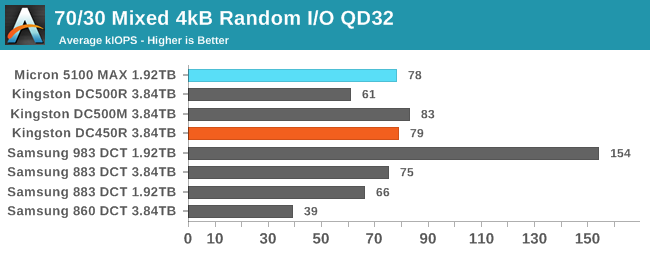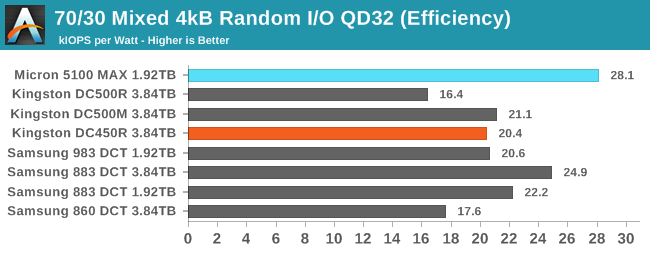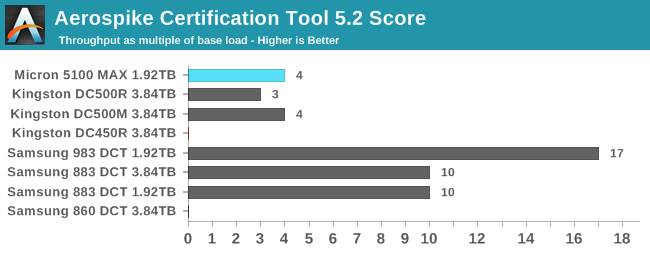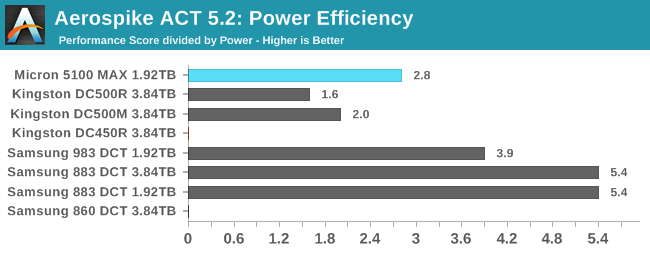Enterprise SATA SSDs: Can Budget 2020 beat Top Line 2017?
by Billy Tallis on February 4, 2020 11:00 AM ESTMixed Random I/O Performance
Real-world storage workloads usually aren't pure reads or writes but a mix of both. It is completely impractical to test and graph the full range of possible mixed I/O workloads—varying the proportion of reads vs writes, sequential vs random and differing block sizes leads to far too many configurations. Instead, we're going to focus on just a few scenarios that are most commonly referred to by vendors, when they provide a mixed I/O performance specification at all. We tested a range of 4kB random read/write mixes at queue depth 32, the maximum supported by SATA SSDs. This gives us a good picture of the maximum throughput these drives can sustain for mixed random I/O, but in many cases the queue depth will be far higher than necessary, so we can't draw meaningful conclusions about latency from this test. This test uses 8 threads each running at QD4. This spreads the work over many CPU cores, and for NVMe drives it also spreads the I/O across the drive's several queues.
The full range of read/write mixes is graphed below, but we'll primarily focus on the 70% read, 30% write case that is a fairly common stand-in for moderately read-heavy mixed workloads.

With a 70% read/30% write mix, the low-end SATA drives are able to perform far better than they can for a pure random write test. The Kingston DC450R seems to benefit the most, and it's staying even further above its steady-state write speed than the DC500R does. The Micron 5100 MAX is also performing a bit above expectations, since its spec sheet calls for just 70k IOPS. The end result is that there's no clear performance winner among these SATA drives, and the latest-and-greatest models aren't necessary to get good throughput on this workload.
 |
|||||||||
| Power Efficiency in MB/s/W | Average Power in W | ||||||||
The power efficiency scores are a mixed bag. The Micron 5100 MAX comes out on top, followed by the Samsung 883 DCT. While the Kingston drives draw more power than the other SATA drives on this workload, they generally have enough performance that their efficiency scores aren't too bad.
 |
|||||||||
Looking at the entire range of mixes, we see the Samsung drives showing fairly ordinary steep declines in performance as the workload becomes more write-heavy. The performance curve from the Micron 5100 MAX also looks fairly normal, given that it can maintain a very high write throughput and thus shouldn't bottom out anywhere near as low as the other drives. The Kingston drives are another story. Even though this mixed random IO test was run immediately after the random write tests, these drives don't appear to have remained in a steady-state of being saturated with writes. The DC500R may be closest, with relatively low performance except for the pure-read phase of the test. The DC450R is slower and less consistent than the DC500M, but still definitely punching above its weight here.
Aerospike Certification Tool
Aerospike is a high-performance NoSQL database designed for use with solid state storage. The developers of Aerospike provide the Aerospike Certification Tool (ACT), a benchmark that emulates the typical storage workload generated by the Aerospike database. This workload consists of a mix of large-block 128kB reads and writes, and small 1.5kB reads. When the ACT was initially released back in the early days of SATA SSDs, the baseline workload was defined to consist of 2000 reads per second and 1000 writes per second. A drive is considered to pass the test if it meets the following latency criteria:
- fewer than 5% of transactions exceed 1ms
- fewer than 1% of transactions exceed 8ms
- fewer than 0.1% of transactions exceed 64ms
Drives can be scored based on the highest throughput they can sustain while satisfying the latency QoS requirements. Scores are normalized relative to the baseline 1x workload, so a score of 50 indicates 100,000 reads per second and 50,000 writes per second. Since this test uses fixed IO rates, the queue depths experienced by each drive will depend on their latency, and can fluctuate during the test run if the drive slows down temporarily for a garbage collection cycle. The test will give up early if it detects the queue depths growing excessively, or if the large block IO threads can't keep up with the random reads.
We used the default settings for queue and thread counts and did not manually constrain the benchmark to a single NUMA node, so this test produced a total of 64 threads scheduled across all 72 virtual (36 physical) cores.
The usual runtime for ACT is 24 hours, which makes determining a drive's throughput limit a long process. For fast NVMe SSDs, this is far longer than necessary for drives to reach steady-state. In order to find the maximum rate at which a drive can pass the test, we start at an unsustainably high rate (at least 150x) and incrementally reduce the rate until the test can run for a full hour, and the decrease the rate further if necessary to get the drive under the latency limits.
We have updated to version 5.2 of ACT, and these numbers are not exactly equivalent to our previous reviews.

Despite its generous overprovisioning, the Micron 5100 MAX turns in a much lower ACT score than the Samsung 883 DCT. Even though the 5100 MAX can sustain high random write throughput (by SATA standards), its poor QoS prevents it from scoring well here. The Kingston DC450R, like the similarly low-end 860 DCT, cannot meet the test's QoS requirements even at the 1x workload rate.
 |
|||||||||
| Power Efficiency | Average Power in W | ||||||||
Most of the SATA drives hover at or just below 2W during the ACT test, but the Micron 5100 MAX averages 1.4W. That allows it to earn an efficiency score that is clearly better than the Kingston DC500s, but still only half that of the Samsung 883 DCT.










20 Comments
View All Comments
FunBunny2 - Wednesday, February 5, 2020 - link
"So, even a "serious" database running on any reliable disk (ie: one not lying about flushes) will be 100% functional/safe; however, performance will tank."industrial strength RDBMS still offer (on *nix OSs, at least) raw devices, which means the database engine does all the I/O, and always (IIRC) runs with more integrity guarantees and efficiency. it's just that *nix OSs have gotten sufficiently better at both over the last couple of decades that most RDMBS app developers discourage their clients from configuring that way.
FunBunny2 - Wednesday, February 5, 2020 - link
"There is a difference between data integrity and persistency, but power-loss protection is needed for either."depends on what the definition of 'it' is. way back in the late 80s and early 90s, SQL databases ran on machines without UPS or other forms power persistence. what industrial strength RDBMS did guarantee is that a use session would lose only its last in-memory transaction. app developers took this into account when designing transactions. they still have to, since any number of failure modes exist beyond just pulling the plug. RDBMS did, and still do, only guarantee integrity of data written to the write-ahead-log, which is where in-memory data is flushed on transaction completion. widespread use of storage class memory, and OS support for same beyond simulating a filesystems (gad!), will change this protocol. won't be next week.
Siddhartha - Wednesday, February 5, 2020 - link
Is there something I can do to stop your endless loop video popups? I understand you earn your living with advertising but the popups actually block your content. I usually spend a couple minutes on website and go somewhere because of the popups.RealBeast - Wednesday, February 5, 2020 - link
What video popups? cough, MVPS host file blocking, coughleexgx - Wednesday, February 5, 2020 - link
I exclusively use edge mobile browser on this website (the forums are even worse a floating video that follows you when you move up and down blocking over 70% of the page) 3 other sites that I use it on as well as they launch full screen ad when you click on a link for the first time or i page ads are floating with the page or randomly opening other pages when you try to swipe down (it thinks your tapping the add when your trying to pull down)Supercell99 - Wednesday, February 5, 2020 - link
Nothing about the Kingston drives are "Enterprise" . The DWPD are nothing special. The lack of power loss protection capacitors is a deal breaker. I don't care if it is read heavy. Enterprise means, critical data and business use with $$$$ at stake. Loss of data and downtime is very expense. No power caps and <1 DWPD makes this just another SATA SSD, "Enterprise" is some label they threw on to make some extra cash from suckers.Foeketijn - Saturday, February 8, 2020 - link
I bought a samsung 983 for 200 something euro's.Nice to install Windows server in about 2 minutes (and then need about 10 to go thought the bloatware options).
dromoxen - Wednesday, February 12, 2020 - link
Its a shame they couldnt do a quick re-write of the firmware , nobody? needs 42% over provisioning. Maybe take it down to 5,10.. that can be changed on installation. Voila , a shedload of extra capacity, which I would presume is the second selling point , after simply being a SATA ssd.